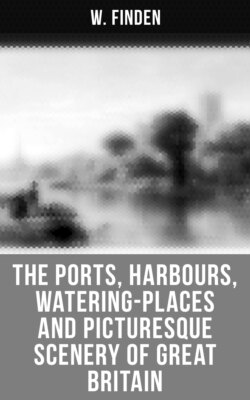Читать книгу The Ports, Harbours, Watering-places and Picturesque Scenery of Great Britain - W. Finden - Страница 23
На сайте Литреса книга снята с продажи.
NEWCASTLE UPON TYNE.
ОглавлениеTable of Contents
The view of Newcastle is taken from the Gateshead shore, on the south side of the river Tyne, about a quarter of a mile below the bridge. From the point chosen by the artist, a better and more characteristic view of the town is obtained than from any other station. The line of vessels, extending from the right of the engraving to the bridge, indicates the quay—the longest in England, except that of Yarmouth—and which, on a Saturday, when the country people come in to market, is one of the most crowded thoroughfares in the kingdom. The steeple that rises above the houses to the right is that of All Saints. Between All Saints and the Castle—which is distinguished by its modern turrets and battlements—is the famed steeple of St. Nicholas; this the Rev. Dr. Carlyle, vicar of Newcastle, in 1804, declared to be, in his opinion, "the most beautiful fabric existing in the world: surpassing the Cathedral of St. Sophia, at Constantinople; the Mosque of Sultan Saladin, at Jerusalem; the Church of St. Peter, at Rome; and even the Temple of Minerva, at Athens." The modern building, with a Grecian portico, in front of the Castle, is the County Court, where the assizes for the county of Northumberland are held. The Exchange is hidden by the sails of the large vessel, towards the middle of the engraving; and the bridge excludes a view of the Mansion House, which stands in friendly neighbourhood with a glass-house and a soapery, in a narrow street, with a most expressive name—the "Close."
The town of Newcastle, though its present name is not older than the reign of William the Conqueror, claims to be a place of great antiquity. The Roman Wall—which extended from Wallsend, about four miles eastward of Newcastle, to Bowness on the Sands, in Cumberland—crossed the site of the present town; and it is certain that there was a Roman station here, the southern wall of which probably ran along the high ground overlooking the river in front of the old castle. In the list of stations, with their garrisons, on the line of the wall, as given in the Notitia, Pons Ælii occurs as the next station to Segedunum; and our best informed antiquaries appear to agree in assigning the latter name to the station at Wallsend, and the former to the station at Newcastle. The name Pons Ælii, however, occurs in no other ancient work as the name of a station on the line of the wall, and no inscription has been discovered which might confirm the opinion of its being the name of the station at Newcastle. Different writers also have interpreted the list of stations in the Notitia from different ends, and at the present time the situation of several places remains undecided.
The Tyne is navigable as high up as Newcastle, about ten miles from its mouth, for vessels of 250 tons burden, though in some places between Newcastle and Shields, even in the middle of the stream, its depth does not exceed four feet at low water. A little below Hebburn quay, about half-way between Newcastle and Shields, it is not unusual to see three or four small steam-boats, which do not draw more than three feet water, lying aground in the very mid-channel at the last quarter ebb, and waiting for the flood tide to set them afloat. A few years ago, the corporation of Newcastle, as conservators of the river Tyne, employed a steam-boat to scratch away the sand in shallow places, by means of a kind of harrow, which she towed after her. Since the accession of the present corporation to office, a dredging machine has been employed, and if they proceed in their plans for the improvement of the river as they have begun, they will merit the thanks of every person interested in the trade of the town.
But, however praiseworthy may be their efforts for the deepening and cleansing the bed of the Tyne, the present year (1853) has exhibited melancholy testimony that the streets, lanes, and alleys of Newcastle call aloud for the expenditure of the municipal funds—if the lives of the inhabitants are not of less value than the commerce of the port. The ill-drained and badly-ventilated dwellings of some of the more densely-peopled portions of the town have suffered more from the attacks of cholera than any other place in the kingdom.
The chief exports from Newcastle, besides coals, are pig and sheet lead; anchors, and chain cables, with other articles of wrought iron; bottles, plate and crown glass; brown and white paper; common leather gloves, manufactured at Hexham; leather; hams and butter; grindstones, obtained on Gateshead Fell; fire-bricks; alkalies; soap; and Epsom salts. This list comprises the principal articles which constitute the cargo of a Newcastle trading vessel proceeding to London.
BLYTH.
